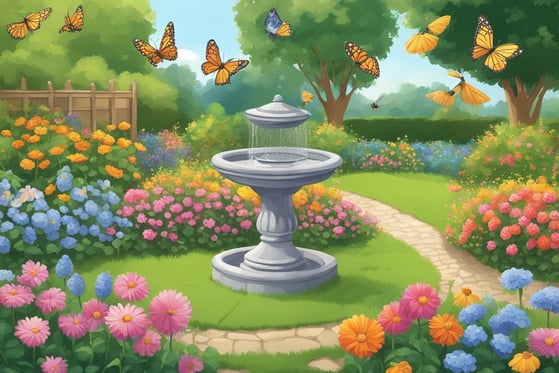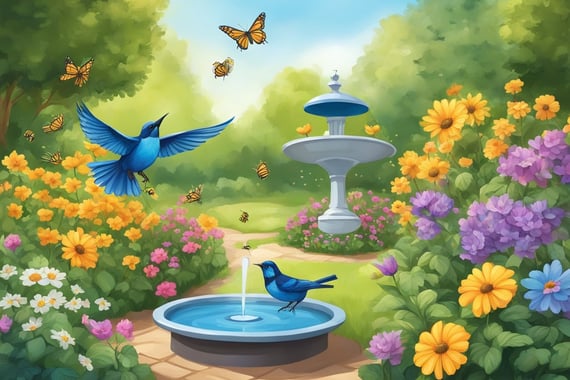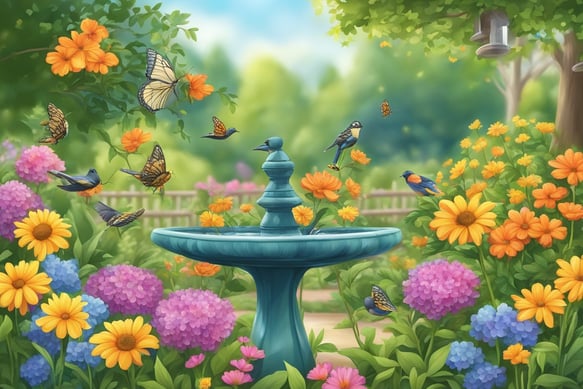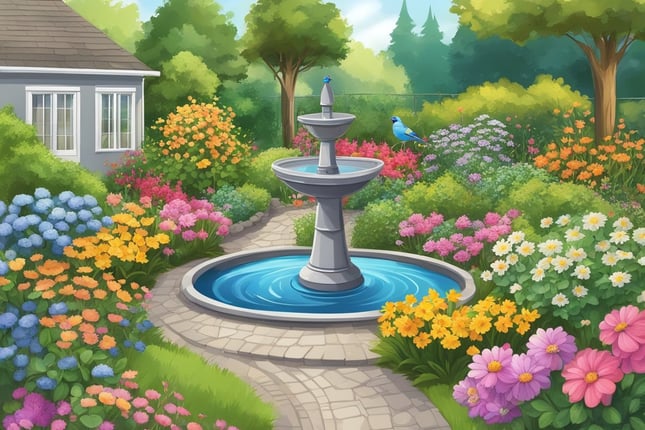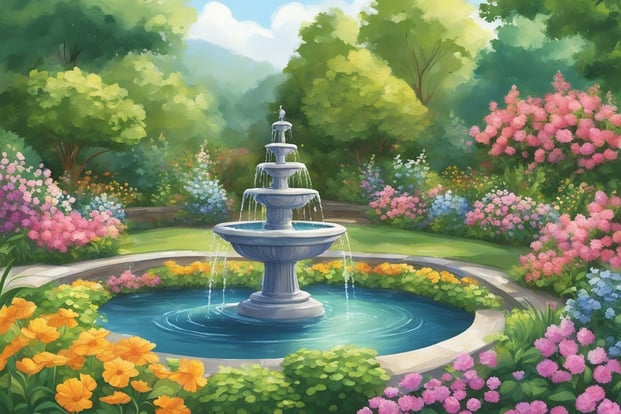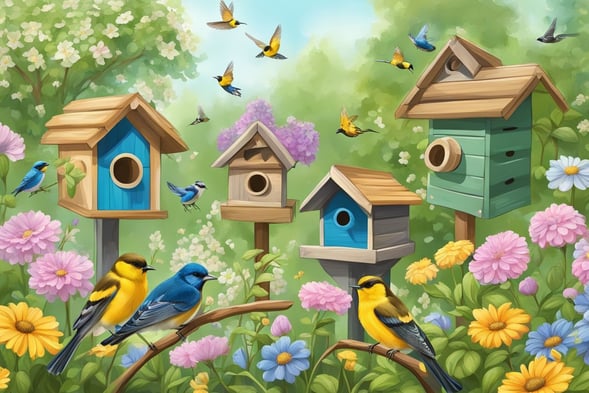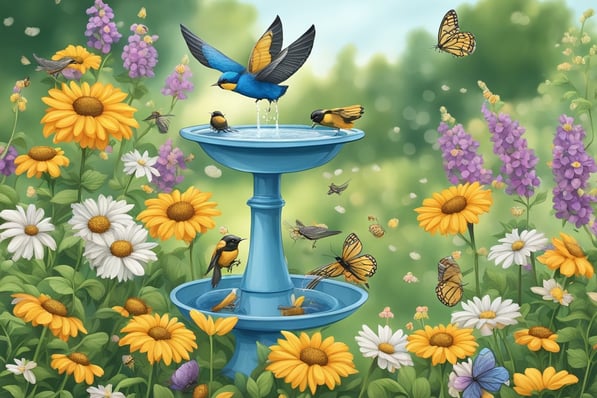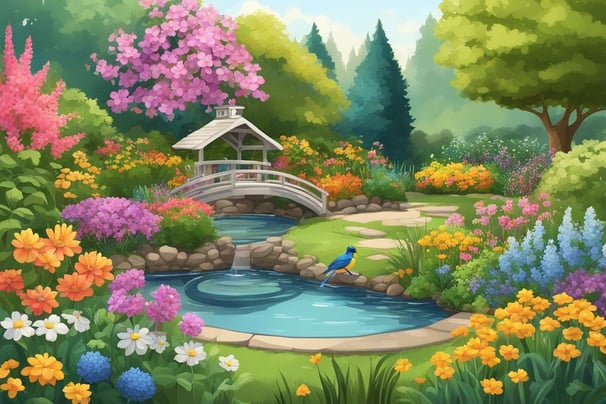How to Create a Wildlife Haven: Top Plants and Features to Attract Birds and Pollinators to Your Garden
Transform your garden into a vibrant haven for local wildlife! This guide shares simple ways to attract birds, butterflies, and beneficial pollinators by choosing the right plants, adding feeders, and incorporating water features. Discover easy steps to encourage biodiversity in your backyard and create a beautiful, eco-friendly space that supports nature.
11/8/20248 min read
Creating a Wildlife-Friendly Garden: Boosting Biodiversity with Plants and Features
Creating a wildlife-friendly garden is a rewarding endeavor that benefits both the environment and the gardener. By selecting the right plants and features, one can transform any garden into a haven for birds and pollinators. Introducing native flora not only enhances the natural beauty of the garden but also supports local wildlife, providing essential food sources and habitats.
Incorporating a variety of plants is key to attracting different species. Consider adding nectar-rich flowers, seed-producing plants, and shrubs for nesting. These elements create a diverse ecosystem, inviting a range of creatures to visit and thrive.
Beyond plants, the addition of feeders and water sources can significantly increase a garden's appeal to wildlife. Providing fresh water and food encourages birds and pollinators to frequent the area, making the garden a lively spot for observing nature.
Benefits of a Wildlife-Friendly Garden
Enhancing Biodiversity
A garden that welcomes wildlife plays a crucial role in supporting local ecosystems. By providing diverse plants, it attracts various species of birds and pollinators. This diversity helps maintain ecological balance and promotes the health of plant communities.
Natural Pest Control
Welcoming birds and beneficial insects into the garden can naturally reduce pest populations. For example, ladybugs and certain bird species feed on aphids and other common pests, reducing the need for chemical interventions.
Improved Pollination
Pollinators like bees and butterflies are essential for the pollination of fruits, vegetables, and flowers. A wildlife-friendly garden enhances pollination rates, contributing to healthier plant growth and increased harvests in fruit and vegetable gardens.
Educational Opportunities
These gardens offer valuable learning experiences for families and communities. Observing wildlife behaviors and plant interactions provides insights into nature's complex systems, fostering an appreciation for the environment.
Aesthetic and Sensory Enjoyment
Gardens that support wildlife often boast a vibrant display of colors, sounds, and scents. The presence of birds, butterflies, and bees adds dynamic visual and auditory elements, enhancing the overall gardening experience.
Environmental Benefits
A wildlife-friendly garden contributes positively to the environment. Plants and trees can improve air quality, while soil rich in organic matter supports water retention and reduces runoff. These gardens might also serve as key habitats for endangered or threatened species, aiding conservation efforts.
Planning Your Garden Layout
A well-organized garden layout can enhance its appeal to birds and pollinators. Focusing on local wildlife preferences, promoting diversity, and structuring microhabitats encourages a lively ecosystem.
Considering Local Wildlife
Knowing the specific birds and pollinators in the area helps in planning. Research which species visit the area for food and nesting. Native plants are essential because they thrive without much maintenance and attract local fauna.
Creating a list of regional plants can be beneficial. Some species prefer certain flower colors or shapes, so matching these preferences can enhance attractiveness. To cater to different wildlife, consider varied flowering seasons to provide continuous resources.
Design for Diversity
Incorporating a range of plant heights and structures in the garden can cater to different species and provide necessary resources. Layering plants creates shelter and nesting sites at various levels.
Use a variety of plants, including trees, shrubs, and herbaceous species. A mix ensures blooms across the seasons. This attracts different pollinators throughout the year and ensures a continuous food supply.
Integrating colorful flowers with varying bloom times increases appeal. This diversity can lead to a more balanced and resilient garden ecosystem.
Creating Microhabitats
Large gardens can be divided into sections with different conditions to support a wide variety of life. Introduce elements like logs, rocks, or even small ponds to create habitats.
Microhabitats should include sunny spots, shaded areas, and moist zones to cater to a wider range of species. These variations provide nesting, feeding, and overwintering locations.
Small water sources or shallow baths can attract birds and insects. Keeping them clean and refilling regularly ensures they remain hospitable. Including natural features promotes self-sufficiency and minimizes the need for external inputs.
Selection of Plants
Choosing the right plants for a wildlife-friendly garden involves understanding native species, supporting pollinators, and providing food year-round. The focus is on plants that encourage local biodiversity and create a sustainable environment for various wildlife.
Native Plant Species
Selecting native plants is crucial for a successful wildlife garden. Native species are adapted to the local climate and soil conditions, making them easier to grow and maintain. These plants provide natural food and shelter for local wildlife.
A few examples include Coneflowers (Echinacea) and Milkweed (Asclepias). Coneflowers are known for attracting butterflies and bees. Milkweed supports monarch butterflies, offering a habitat for them to lay eggs. Integrating native species helps harmonize the garden with the local ecosystem.
Plants for Pollinators
Gardens attracting pollinators like bees, butterflies, and hummingbirds play a vital role in maintaining biodiversity. Plants such as Lavender, Bee Balm, and Sunflowers are excellent choices.
Lavender not only adds fragrance but also attracts bees. Bee Balm serves as a magnet for both bees and hummingbirds. Sunflowers provide nectar and pollen, benefiting a wide range of pollinators. Opting for a variety of flowering plants ensures a constant supply of resources throughout the growing season.
Year-Round Food Sources
Offering a consistent food supply through all seasons is key to supporting wildlife. In spring and summer, flowering plants like Lupines and Black-Eyed Susans can serve admirably. For autumn and winter, select berry-producing varieties such as Winterberry and Holly.
Winterberry keeps its red berries during cold months, sustaining birds. Holly provides both food and shelter. Along with these, consider evergreens like Pine or Spruce, which provide seeds and shelter during winter. Ensuring year-round resources helps support wildlife populations throughout the year.
Water Features
Integrating water features like ponds and birdbaths creates an inviting atmosphere for various bird species and pollinators. Water sources in a garden serve as drinking and bathing spots, and even small additions can have a big impact.
Ponds and Water Bodies
A pond can become the centerpiece of a wildlife-friendly garden. Adding native aquatic plants improves water quality and provides habitat and food for insects and amphibians. Fish, like goldfish or koi, can help control mosquito larvae. Shallow edges allow birds and mammals to access the water easily while deep areas provide refuge for aquatic creatures.
Including a small pump or waterfall can keep the water oxygenated, benefiting fish and reducing algae growth. A variety of plants, including lilies and reeds, can attract dragonflies and provide perching spots for birds. Ponds, while requiring more effort, enrich the garden ecosystem and enhance biodiversity.
Birdbaths and Drippers
Birdbaths offer a simple yet highly effective way to provide fresh water to garden inhabitants. Positioned in a sunny yet sheltered spot, a birdbath should be filled with clean water regularly.
Incorporating drippers or misters can entice even more bird species by simulating the sound of raindrops. Choosing birdbaths with a rough surface or adding pebbles helps birds grip and feel secure. By varying height levels, from ground to elevated forms, a variety of species can be accommodated, promoting avian diversity in the garden.
Bird Feeders and Nesting Boxes
Incorporating bird feeders and nesting boxes into a garden space enhances its appeal to birds. These additions provide essential food sources and safe nesting environments, thereby encouraging avian visits and promoting biodiversity.
Types of Bird Feeders
Choosing the right bird feeder depends on the birds one wishes to attract. Seed feeders are versatile and can attract finches, sparrows, and other seed-eating birds. These feeders often come in tube designs with multiple perches.
Suet feeders are excellent for attracting species like woodpeckers and nuthatches. They provide a high-energy food source that is especially valuable in colder months.
Hummingbird feeders are specialized to cater to birds that sip nectar. They usually have bright, attractive colors and should be cleaned regularly to prevent mold growth.
When selecting feeders, consider materials such as metal or sturdy plastic for durability. The location is also vital—keeping feeders at a safe distance from potential predators helps ensure bird safety.
Choosing the Right Nesting Boxes
Nesting boxes support bird population growth by providing secure places for birds to raise their young. Size and entrance hole dimensions matter, as these inform which birds are likely to use them. For example, a large entrance suits larger birds like owls, while smaller holes are better for species like wrens.
Materials for nesting boxes should be weather-resistant and non-toxic. Wooden boxes are popular for their insulating properties. Designing boxes with ventilation and drainage ensures a comfortable, dry environment for nesting birds.
Installation height and location influence safety and occupancy. Mount boxes away from prevailing winds, ideally facing an open area rather than dense bush. Annual maintenance, such as cleaning before nesting season, keeps boxes inviting and functional year after year.
Offering Shelter
Providing shelter in a wildlife-friendly garden is crucial for attracting and supporting various species. Natural features such as hedges, bushes, rock piles, and logs offer protection and nesting opportunities. These elements create a refuge for birds and pollinators, offering them a safe environment to thrive.
Hedges and Bushes
Hedges and bushes serve as excellent shelter options for birds and small mammals. Dense foliage provides protection from predators and harsh weather. Plants like hawthorn, holly, or elderberry can be specifically chosen as they cater to the needs of local wildlife while bearing fruits and berries, adding a food source.
Native shrubs are preferable because they offer a familiar habitat and often support local insect populations. These plants can enhance the garden's ecosystem by encouraging a balance between prey and predator species.
Pruning practices should be mindful, allowing enough density for shelter without over-trimming. Leaving some areas of the garden a bit untidy can significantly benefit wildlife, as these areas become natural hideaways.
Rock Piles and Logs
Rock piles and logs contribute to a natural and effective sheltering system. These elements provide cool, damp environments ideal for insects, amphibians, and reptiles. By maintaining a variety of shapes and sizes, gardens can cater to different species that seek refuge.
Stacking logs can also create nesting areas for various insects, while rotting wood serves as a valuable resource for fungi and decomposers. Logs can be arranged artistically to blend with the garden's landscape, ensuring they are both functional and aesthetically pleasing.
Placement matters; ensure these features receive some sun and shade, offering a microhabitat supportive of diverse life forms. This helps in fostering a biodiverse garden environment, promoting healthy interactions within nature.
Garden Maintenance Practices
Garden maintenance is key to creating a wildlife-friendly environment. Adopting pesticide-free methods and performing seasonal cleanups can greatly enhance the habitat for birds and pollinators.
Pesticide-Free Gardening
Pesticide-free gardening prioritizes natural pest control methods. Beneficial insects like ladybugs and praying mantises help control aphid populations, reducing the need for chemicals. Companion planting enhances pest control by pairing plants that deter insects. For example, planting marigolds next to tomatoes can repel nematodes.
Organic fertilizers such as compost or well-rotted manure nourish the soil without harming beneficial microorganisms. Mulching conserves moisture and prevents weed growth, further reducing pest habitats. Encouraging this ecosystem balance supports thriving plant life and attracts local wildlife naturally.
Seasonal Cleanup Routines
Seasonal cleanup routines are essential for maintaining a sustainable garden. In spring, remove dead plant debris to prevent disease and allow for new growth. This process also prepares bedding areas for sowing seeds and planting. Summer involves pruning overgrown plants to minimize hiding spaces for harmful pests.
During fall, clean up fallen leaves and decaying vegetation while leaving some leaf litter to provide winter cover for insects and small wildlife. Composting this material enriches the soil, promoting a strong foundation for the next growing season. By following these practices, gardeners maintain a habitat supportive of wildlife throughout the year.
